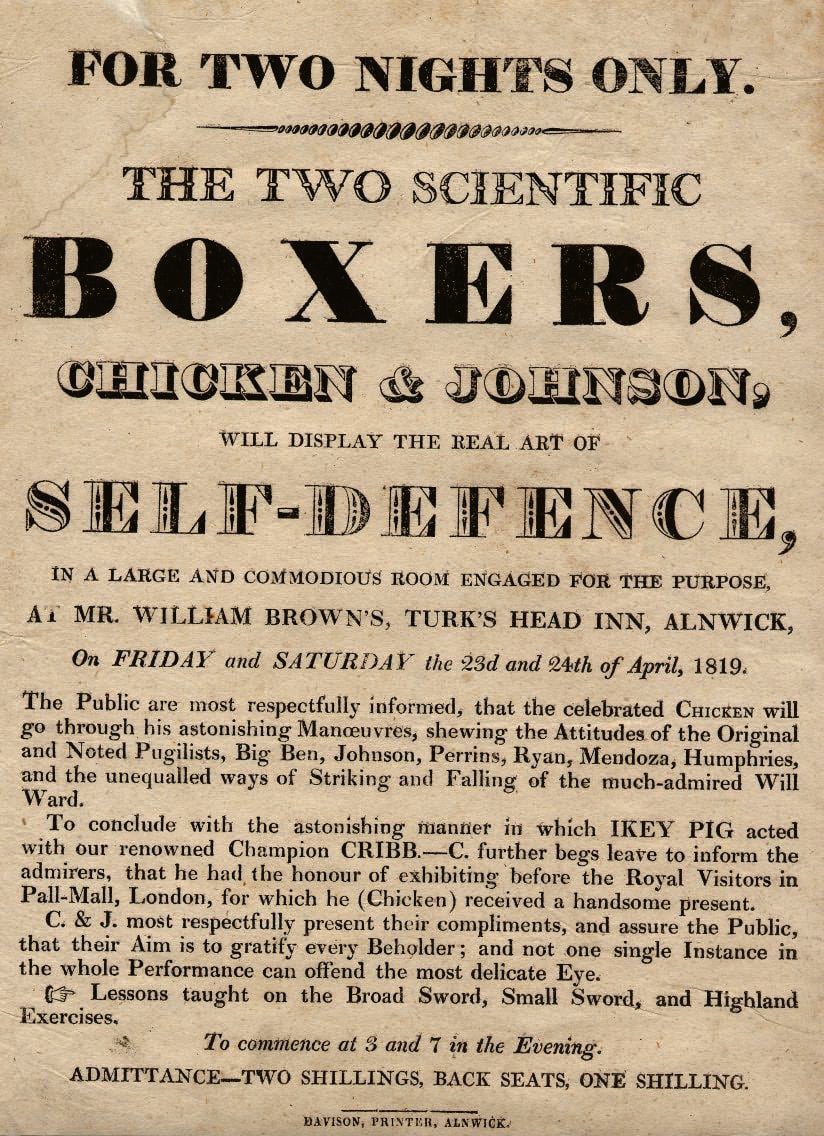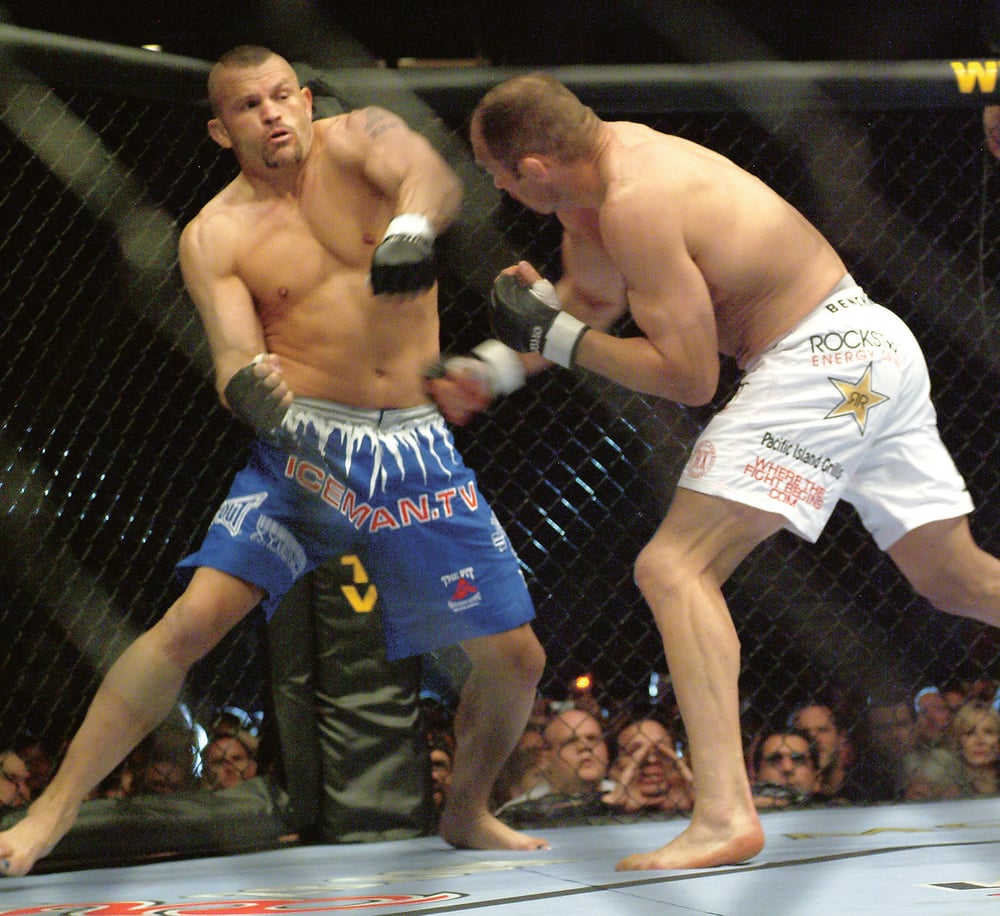
Issue 005
July 2005
A Puncher’s Chance - Boxing in Mixed Martial Arts By Hywel Teague
Boxing is an integral part of Mixed Martial Arts (MMA), in that all fighters must have knowledge of it to be able to compete. It is one of the world’s oldest combat sports and, without doubt, is easily the most recognisable. Known to millions around the world, boxing is big business. The best-known fighters command multi-million dollar pay days and some — like Ali, Tyson, Sugar Ray — have become part of the public consciousness. Everyone knows who they are and why they are famous — they fight.
To the untrained eye boxing can seem little more than a barbaric contest between two brain-damaged pugilists, but it is actually one of the most sophisticated and highly developed forms of unarmed combat known to man. Today’s fighters are athletes of the highest calibre, with teams of trainers behind them that look after every area of their physical and mental well-being. It hasn’t always been this way of course.

HISTORY OF BOXING
The origins of boxing stretch back to the ancient Olympics. Boxing contests back then were not so different from today, in that they outlawed holding, striking of the genitals, and were fought until one of the contestants was unable to continue. The only protection permitted was the himantes, straps of soft ox-hide wrapped around the fists, but — as in pankration — the Romans replaced these with the caestus, vicious brass knuckles that could maim and kill.
Over many years boxing continued to exist but came to prominence in the middle ages. At this time boxing was far more reminiscent of MMA, in that it had little in the way of standard boxing rules and was literally ‘no holds barred’. It began to evolve into the boxing we know today with the introduction first of Broughton’s rules (which forbid gouging and hitting a downed opponent), then London Prize Fighting Rules (a period when rounds were introduced) and latterly by the famous Marquis of Queensbury rules. The Queensbury rules made gloves compulsory, stated rounds should be three minutes long and outlawed all forms of wrestling.
DEVELOPMENT IN THE 20TH CENTURY
With a standardised set of rules available legitimacy was given to what was dubbed the noble art and, though once illegal in the UK and the US, boxing developed into a highly popular sport. Throughout the 20th Century boxing has developed on many levels. The professionals enjoy their status as some of the most recognised sports stars in history, while amateur competition thrives at all levels of society and is an Olympic sport.
Even still, in recent years boxing has witnessed something of a decline. Public fears over participant safety and numerous high profile cases of serious injury have all taken their toll on boxing’s reputation, and while still drawing massive pay-per-view audiences around the world, the appeal of boxing seems to have waned in the face of emerging sports such as MMA.
BOXING VS MMA
When the first Ultimate Fighting Championship (UFC) was held it was billed as a challenge to see who had the most effective style of fighting (in fact, it was originally devised as a tool for marketing Gracie-style Brazilian Jiu-Jitsu, but that’s another story). With practitioners from various different martial arts, including savate, kung fu and wrestling, it was only right that a representative of boxing be included.
The boxer selected to appear in the first UFC was light-heavyweight Art Jimmerson. Jimmerson was no powerhouse in boxing but had a solid record of over 30 victories and held a version of a North American title. He proved to be woefully ill-prepared for his first MMA fight though, and entered the ring wearing one 12oz boxing glove, his other fist bare knuckle. Royce Gracie took him down without a punch thrown and Jimmerson, whether scared he may be hurt or simply thinking of the guaranteed win-or-lose appearance fee of $20,000, submitted before Gracie had a chance to do anything.
This led to boxing being heavily derided by followers of MMA. Arguments as to whether the heavyweight champion of the world would beat an MMA fighter raged to and fro. The fact is that boxing in itself is a highly refined and effective form of fighting, but when used in isolation in a competition where kicking and grappling is allowed it quickly falls short. Jimmerson is not the only boxer to have found this out. Trevor Berbick, a former WBC heavyweight champion, was due to fight Nobuhiko Takada in what he thought was to be a fixed fight based on shoot wrestling rules. He soon found out how boxing comes up short against a well-rounded fighter, literally jumping out of the ring after Takada had given him a taste of what leg kicks are like. Most recently, Kazuyuki Fujita submitted former cruiserweight champion Imamu Mayfield with an arm-triangle choke under modified MMA rules.
WHY BOXING HAS TO BE ADAPTED FOR MMA
Punching in MMA is different to that of boxing for a number of key reasons. First is the kicking element: in MMA you simply cannot walk into punching range. In boxing two fighters would move into range behind a jab, but the leg is longer than the arm and any jab would fall short compared to a roundhouse to the legs or a front kick to the body.
Then there is also the takedown factor. If you are fighting a grappler and you aim high and begin to throw punches at his head, he will level change underneath them and shoot in for a takedown. The other factor is footwork and body movement. Footwork in boxing and MMA is very different as boxers can be on their toes, pivoting and skipping in and out of distance, slipping in and out with no worry that their opponent will try to trip them, tie them up or take them down.
For boxing purists this is all too much to bear. A die-hard boxing fan will lament that the punching found in MMA is the bastard son of that found in boxing. True, sometimes MMA fighters don’t have the prettiest of boxing skills, but this can be put down to the fact that they must cross train in so many different areas that they are unable to refine their striking skill to that of an elite-level boxer.
ANALYSIS OF STYLES OF PUNCHING IN MMA
As we’ve established that there is an absence of ‘real’ boxing in MMA, what is it that people are doing when they’re swinging their arms about wildly? Well, if you believe the die-hard boxing fans, not a lot. The subject of the lack of technique many MMA fighters possess when it comes down to pure punching is a touchy one, but many have developed their own distinct styles and strategies. Using specific fighters as examples, we will touch upon some of those regularly seen.
EMELIANENKO FEDOR
Fedor claims his background is in judo, sambo and boxing. If indeed he really has trained boxing, chances are it was in military-style milling and not much else. He uses his hands well, and has huge strength and power behind his punches, but his style is probably so effective simply due to it being so unorthodox. But we should not forget that Fedor is a not a stand up striker by choice. His prerogative is to get his opponent on their back so he can either smash away with his murderous ground ‘n’ pound or submit them. Mostly, his striking is used as an entry into the clinch range; he will blitz in behind swinging hooks and overhand rights, stunning his opponent with his shots and tying you up in a clinch before taking it down to the mat.
What is interesting though is the way in which Fedor uses his knuckles. With the smaller surface area and lesser padding of MMA gloves, he angles his fists so that when throwing a right hook he will tilt his hand as if pouring a jug of water and strike with the top knuckle of his fist (the least padded part of the glove). It is a very unusual way of striking, but watch his fights with Gary Goodridge and Fujita for examples of it in action.

CHUTE BOXE
Due to their extensive background in Thai-boxing, Chute Boxe fighters have an instantly recognisable Thai stance. With their feet relatively close together and with their hips square to their opponent they are poised to deliver punches and kicks from any angle. While being square on makes them a larger target it also gives them two advantages: firstly, every shot they deliver is like a cross and they can drive straight lefts and rights with equal power. Secondly, having their hips square lets them sprawl quicker, something highly important when your whole game is about knocking people out on their feet.
A major disadvantage of this square stance though, is the lack of mobility. As they plant their feet to power in those punches they have no ability to angle off and their head movement becomes non-existent. If you’re going to learn to strike like a Chute Boxe fighter, make sure you can take a shot because you’re going to end up getting clipped a lot.
DIRTY BOXING
Popularised by fighters such as Randy Couture, dirty boxing is the name given when fighters trade punches in the clinch range. In a normal boxing match the contestants would have been broken apart at this stage. Well-suited to wrestlers, the technique is also used by almost every MMA fighter. It involves the use of holding an opponent with one arm and striking with the other or even tactics such as standing arm locks and striking with the elbows.

HOW BOXING MIGHT INFLUENCE MMA IN THE FUTURE
Some MMA fighters have made great strides in their efforts to learn
boxing skills though, and one such fighter is former Pride Heavyweight champion Antonio Rodrigo ‘Minotauro’ Nogueira. Only a few years ago he was what is commonly known as a grappler-boxer. Standing square to his opponent and simply arm punching away, his striking skills were indicative of someone who was a master grappler. Having spent most of his life having never thrown a punch, it was clear that he did not know how to strike properly.
Fast-forward five years to his fight with Sergei Kharitonov, and the contest was the closest thing to a boxing match in MMA we have ever seen. To begin with neither fighter was particularly eager to take it to the floor, and we witnessed the two deftly jabbing, slipping and swapping punches in one of the tidiest displays of boxing outside a traditional boxing ring.
Boxing skills in MMA are developing at such a rate that many are able to make frequent crossovers to fight under the Queensbury rules. Some
MMA fighters who also hold boxing records include Chris ‘Lights Out’ Lytle (12-1-1 in professional boxing) and Jens ‘Lil Evil’ Pulver (4-0-0 in professional contests).
As time goes by the standard of punching in MMA will undoubtedly improve. Everyone knows that even a world boxing champion would fail miserably in MMA, but could we one day see an active MMA fighter hold a title in professional boxing? Only time will tell. ƒ










